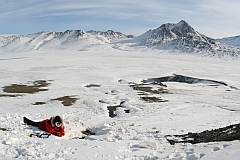Home
Recent Highlights
Objectives
Research themes
Training opportunities
How to apply
Investigators
Collaborators
Partners
Students
Seminars
Program management
Annual meetings
Contact us
Recent Highlights
Objectives
Research themes
Training opportunities
How to apply
Investigators
Collaborators
Partners
Students
Seminars
Program management
Annual meetings
Contact us
Contact information:
Ms Yella Jovich-Zahirovich
Project Coordinator
Tel. 514-398-7824
Fax. 514-398-7990
Dr. Lyle Whyte
Principal Investigator
Tel. 514-398-7889
Fax. 514-398-7990
NSERC CREATE
Canadian Astrobiology Training Program
Canadian Astrobiology Training Program




CREATE -- CATP
CATP research activities will be structured around 4 major themes that are explicitly linked to the domains of expertise of the CATP co-applicants: Extremophiles, Biosignatures, Astrobiology Instrument and Technology Development, and Planetary Analogues. The 4 themes unite to serve a common purpose: the unambiguous detection of life, extant or extinct, in areas where the existence of life cannot be presupposed.
- Extremophiles and Cryomicrobiology.
Most of the Solar System is cold. Knowing the cold temperature limits of Earth microbial life, and the adaptations used by these organisms in regions where liquid water is scarce or seasonal, will allow us to identify areas that are most likely to contain detectable levels of life. This emerging field, perhaps best described as cryomicrobiology, is presently very poorly understood but crucial for determining the cold temperature limits of microbial life, if such communities can exist and are active in situ at subzero temperatures, and how can we detect such activity? - Biosignatures.
Life in extraterrestrial environments will be revealed indirectly, through the characteristic chemical, mineralogical, or textural features it generates. The ability to recognize these ‘biosignatures’ requires expert effort along two related research tracks. First, biosignatures produced in modern and ancient analogue environments must be documented. Second, the potential for abiotic processes to produce false biosignatures must be explored. Modern astrobiological research on biosignatures has traditionally focused on the first of these two areas. Without experimental examination of the chemical, mineralogical, and textural effects of abiotic processes, it is impossible to evaluate the fundamental null hypothesis of Astrobiology (i.e. ‘no life’). - Astrobiology Instrument and Technology Development.
Planetary missions are becoming increasingly sophisticated in terms of both instrument capabilities and the suite of integrated instruments that they incorporate. The first major challenge for any space mission is to develop instruments that are small and light enough for launch; which can survive the acceleration of a launch vehicle and the radiation environment space; and which can function for extended periods with a reasonable amount of power and successfully relay data. - Planetary Analogues, Exoplanets.
The definition of analogue sites is a critical aspect of Astrobiology that includes Earth sites and extends beyond our Solar System. Analogue sites serve two valuable purposes in astrobiology: to understand the environmental limits of life and as test sites for assessing the performance of life detection instruments intended for inclusion on planetary missions. Analogue studies are driven by the need to understand processes on Earth in order to interpret and ground-truth data sent back from Mars and other planetary bodies by unmanned orbiters and rovers The discovery of exoplanets has both quickened and diversified Among the nearly 300 planets now known are a collection of “SuperEarths” – rocky planets with a few to ten Earth masses. Some of these have been found in the habitable zones around low mass (M) stars. It still remains to determine whether these planets could host extremophile life within the limits that we know it.
©2009 L. Whyte & CATP All Rights Reserved